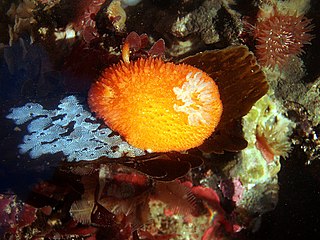 W
WAcanthodoris lutea, the orange-peel doris, is a species of nudibranch or sea slug, a shell-less marine opisthobranch gastropod mollusk in the family Onchidorididae.
 W
WBlepharopsis mendica is a species of praying mantis found in North Africa, parts of the Mediterranean, Middle East and southern Asia, and on the Canary Islands. Devil's flower mantis, Egyptian flower mantis, thistle mantis, and Arab mantis are among its common names.
 W
WThe blue poison dart frog or blue poison arrow frog is a poison dart frog found in the forests surrounded by the Sipaliwini Savanna, which is located in southern Suriname and adjacent far northern Brazil. D. tinctorius azureus is also known by its indigenous Tirio name, okopipi. Its scientific name comes from its azure (blue) color. While frequently considered a valid species in the past, recent authorities treat it as a variant of D. tinctorius.
 W
WThe Chinese fire belly newt is a small black newt, with bright-orange aposematic coloration on their ventral sides. C. orientalis is commonly seen in pet stores, where it is frequently confused with the Japanese fire belly newt due to similarities in size and coloration. C. orientalis typically exhibits smoother skin and a rounder tail than C. pyrrhogaster, and has less obvious parotoid glands.
 W
WThe monarch butterfly or simply monarch is a milkweed butterfly in the family Nymphalidae. Other common names, depending on region, include milkweed, common tiger, wanderer, and black veined brown. It may be the most familiar North American butterfly, and is considered an iconic pollinator species. Its wings feature an easily recognizable black, orange, and white pattern, with a wingspan of 8.9–10.2 cm (3 1⁄2–4 in) A Müllerian mimic, the viceroy butterfly, is similar in color and pattern, but is markedly smaller and has an extra black stripe across each hindwing.
 W
WDasymutilla occidentalis, is a species of parasitoid wasp native to the eastern United States. It is commonly mistaken for a member of the true ant family, as the female is wingless. The species ranges from Connecticut to Missouri in the north and Florida to Texas in the south.
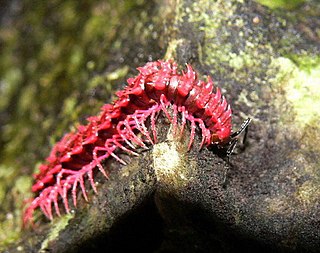 W
WDesmoxytes purpurosea also known as dragon millepede, is a spiny and toxic millipede named for its vivid pink color. It was formally described in 2007 from a specimen collected at the Hup Pa Tard limestone cavern in the Uthai Thani Province of Thailand. Among the largest species of its genus, the adult millipede is approximately 3 cm (1.2 in) long. It lives in the open on leaf litter. Large numbers of them occur after rain showers. The millipede has glands that produce hydrogen cyanide to protect it from predators, which causes it to smell like almonds. Its toxicity is advertised by its aposematic color.
 W
WThe granular poison frog is a species of frog in the family Dendrobatidae, found in Costa Rica and Panama. Originally described as Dendrobates granuliferus, it was moved to Oophaga in 1994. Its natural habitats are tropical humid lowland forests; it is threatened by habitat loss.
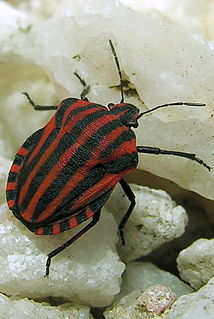 W
WGraphosoma italicum is a species of shield bug in the family Pentatomidae. It is also known as the Striped bug and Minstrel bug.
 W
WGraphosoma lineatum is a species of shield bug in the family Pentatomidae.
 W
WHarpaphe haydeniana, commonly known as the yellow-spotted millipede, almond-scented millipede or cyanide millipede, is a species of polydesmidan ("flat-backed") millipede found in the moist forests along the Pacific coast of North America, from Southeast Alaska to California. The dark coloration with contrasting yellow-tipped keels warn of its ability to exude toxic hydrogen cyanide as a defense. Despite the various common names given the species, the coloration pattern, cyanide defense, and associated almond scent occur in other flat-backed millipedes around the world.
 W
WHeliconius charithonia, the zebra longwing or zebra heliconian, is a species of butterfly belonging to the subfamily Heliconiinae of the family Nymphalidae. It was first described by Carl Linnaeus in his 1767 12th edition of Systema Naturae. The boldly striped black and white wing pattern is aposematic, warning off predators.
 W
WLophocampa caryae, the hickory tiger moth, hickory tussock moth, or hickory halisidota, is a moth in the family Erebidae and the tribe Arctiini, the tiger moths. The species is widely distributed in the eastern half of North America. In other species in this family, the caterpillars acquire chemical defenses from their host plants, so they are potentially toxic or unpalatable, but despite anecdotal claims that this species may also be venomous, no venom has yet been isolated or identified; adverse reactions are characterized as contact dermatitis.
 W
WThe monarch butterfly or simply monarch is a milkweed butterfly in the family Nymphalidae. Other common names, depending on region, include milkweed, common tiger, wanderer, and black veined brown. It may be the most familiar North American butterfly, and is considered an iconic pollinator species. Its wings feature an easily recognizable black, orange, and white pattern, with a wingspan of 8.9–10.2 cm (3 1⁄2–4 in) A Müllerian mimic, the viceroy butterfly, is similar in color and pattern, but is markedly smaller and has an extra black stripe across each hindwing.
 W
WThe near Eastern fire salamander, in Arabic arouss al-ayn, is a species of salamander in the family Salamandridae found in Iran, Iraq, Turkey, Syria, Lebanon, and Israel. Its natural habitats are subtropical dry shrubland and forests, often near rivers and freshwater springs. It is threatened by habitat loss.
 W
WThe peacock-pheasants are a bird genus, Polyplectron, of the family Phasianidae, consisting of eight species. They are colored inconspicuously, relying on heavily on crypsis to avoid detection. When threatened, peacock-pheasants will alter their shapes using specialised plumage that when expanded reveals numerous iridescent orbs. The birds also vibrate their plume quills further accentuating their aposematism. Peacock-pheasants exhibit well developed metatarsal spurs. Older individuals may have multiple spurs on each leg. These kicking thorns are used in self-defense.
 W
WPoison dart frog is the common name of a group of frogs in the family Dendrobatidae which are native to tropical Central and South America. These species are diurnal and often have brightly colored bodies. This bright coloration is correlated with the toxicity of the species, making them aposematic. Some species of the family Dendrobatidae exhibit extremely bright coloration along with high toxicity, while others have cryptic coloration with minimal to no amount of observed toxicity. The species that have great toxicity derive this from their diet of ants, mites and termites. Other species however, that exhibit cryptic coloration and low to no amounts of toxicity, eat a much larger variety of prey. Many species of this family are threatened due to human infrastructure encroaching on their habitats.
 W
WThe striped polecat - also called the African polecat, zoril, zorille, zorilla, Cape polecat, and African skunk - is a member of the family Mustelidae that resembles a skunk. The name "zorilla" comes from the word "zorro", which in Spanish means "fox". It lives predominantly in dry and arid climates, such as the savannahs and open country of Central, Southern, and sub-Saharan Africa, excluding the Congo basin and the more coastal areas of West Africa.
 W
WThe western spotted skunk is a spotted skunk of western North America.
 W
WThe spectacled salamander is a species of salamander in the family Salamandridae.
 W
WThe spotted salamander or yellow-spotted salamander is a mole salamander common in eastern United States and Canada. The spotted salamander is the state amphibian of Ohio and South Carolina. This salamander ranges from Nova Scotia, to Lake Superior, to southern Georgia and Texas. Its embryos have been found to have symbiotic algae living inside them, the only known example of vertebrate cells hosting an endosymbiont microbe.
 W
WThe Sunda stink badger, also called the Javan stink badger, teledu, Malay stink badger, Malay badger, Indonesian stink badger and Sunda skunk, is a mammal native to Indonesia and Malaysia. Despite the common name, stink badgers are not closely related to true badgers, and are, instead, Old World relatives of the skunks.
 W
WA tarantula hawk is a spider wasp (Pompilidae) that preys on tarantulas. Tarantula hawks belong to any of the many species in the genera Pepsis and Hemipepsis. They are one of the largest parasitoid wasps, using their sting to paralyze their prey before dragging it to a brood nest as living food; a single egg is laid on the prey, hatching to a larva which eats the still-living prey.
 W
WThe red milkweed beetle is a beetle in the family Cerambycidae. The binomial genus and species names are both derived from the Ancient Greek for "four eyes." As in many longhorn beetles, the antennae are situated very near the eye–in the red milkweed beetle, this adaptation has been carried to an extreme: the antennal base actually bisects the eye. The milkweed beetle, a herbivore, is given this name because they are generally host specific to milkweed plants. It is thought the beetle, which as an adult feeds on the foliage of the plant, and its early instars, which eat the roots, derive a measure of protection from predators by incorporating toxins from the plant into their bodies, thereby becoming distasteful, much as the monarch butterfly and its larvae do. They feed by opening veins in the milkweed plant, decreasing the beetles' exposure to latex-like sap. When startled, the beetles make a shrill noise. When interacting with another beetle, they make a 'purring' noise. The red and black coloring are aposematic, advertising the beetles' inedibility. There are many milkweed-eating species of insect that use the toxins contained in the plant as a chemical defense. Red milkweed beetles lay egg-clutches in mid-summer near the roots of the milkweed.
 W
WThe variable checkerspot or Chalcedon checkerspot is a butterfly in the family Nymphalidae. It is found in western North America, where its range stretches from Alaska in the north to Baja California in the south and extends east through the Rocky Mountains into Colorado, Montana, New Mexico and Wyoming. The butterfly is usually brown or black with extensive white and yellow checkering and some red coloration on the dorsal wing. Adult wingspan is 3.2–5.7 cm (1.3–2.2 in). Adult butterflies feed on nectar from flowers while larvae feed on a variety of plants including snowberry (Symphoricarpos), paintbrush (Castilleja), Buddleja, Diplacus aurantiacus and Scrophularia californica.
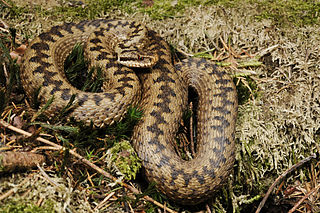 W
WVipera berus, the common European adder or common European viper, is a venomous snake that is extremely widespread and can be found throughout most of Western Europe and as far as East Asia. Known by a host of common names including common adder and common viper, adders have been the subject of much folklore in Britain and other European countries. They are not regarded as especially dangerous; the snake is not aggressive and usually bites only when really provoked, stepped on, or picked up. Bites can be very painful, but are seldom fatal. The specific name, berus, is New Latin and was at one time used to refer to a snake, possibly the grass snake, Natrix natrix.
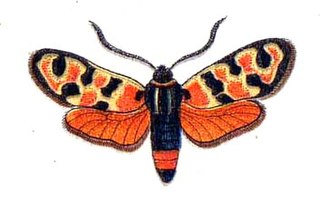 W
WZygaena fausta is a member of the family Zygaenidae, the day-flying burnet moths. Its bright aposematic colours of red, white and black on the wings indicate to possible predators such as birds that it is foul tasting or poisonous. In flight, the bright red abdomen is revealed, contrasting with the white legs and black head and antennae; the thorax is black and white with an eye spot on each side. There appears to be a considerable variation in pattern among specimens from different parts of Europe.